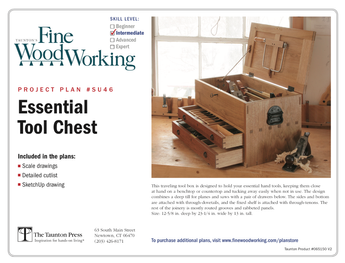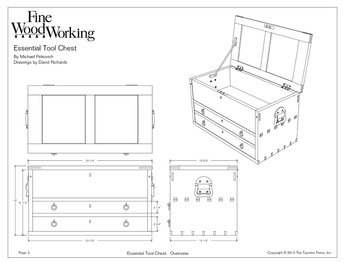Glue Placement and Panel size in Stile and Rail Door
As the pictures show I’m doing a few panel doors, and I’m wondering how to approach the gluing and sizing of the inside panel (1/4” panel inside 3/4” stiles and rails).
For flat sawn white oak stiles and rails, should the panel sit somewhat loose in the grooves to allow for wood movement – Between 1/32-1/8 of play? Or should they be tight inside the grooves, with no room for movement. Adding on to this how should I go about gluing the panel in? Should the length of the groove have a small bead? should I add a few drops in choice places? Or should I avoid glue entirely.
thanks for any help and advice/extra tips!

















Replies
If the panels are smallish and made of a very stable material such as plywood, you can glue them in all 'round. Any expansion./contraction due to moisture changes in the surrounding atmosphere are likely to be very small, with very little differential between the ply of the panels and the real-wood of the rails and stiles.
The advantages of gluing such a small and stable frame and panel is that it makes it a bit stronger and prevents a tiny panel shift that might show a line of different colour between UV-protected parts of the panel (those in the grooves) and the UV-exposed main panel area.
If the panels too are real-wood, even a small frame & panel item risks panels cracking if they're glued all 'round and moisture changes are large in the vicinity of the item.
The tradition is to glue only a small section of panel to top & bottom rails, so the panel stays central in the frame if things expand and contract. This assumes that the panel grain is vertical in the frame (parallel with the stiles grain). A small gap is left between the panel edges and the rail/stile groove-bottoms to allow such expansion around the top/bottom rail centralised glue-dab anchor points.
You can leave a real-wood panel loose in the frame but this risks a movement that exposes one large UV-differentiated colour change on just one side of the panel, as it moves in and out of the stile grooves but only on one side. If the panel itself has a profile around its circumference, this too might end up looking lopsided in the frame as differential expansion acts to shift the panel-frame "mapping" asymmetrically.
A profiled panel that's entirely loose in a frame will also tend to sink down to rest on the floor of the bottom-rail groove, which will also spoil any top/bottom symmetry of the panel in the frame.
You can buy small rubber balls to put all around the frame grooves to fill in the small expansion-gap left between frame-grooves and panel. This allows the panel to expand by squishing the rubber balls but it does so symmetrically in the frame as the balls squish (and expand, when the panel shrinks again) evenly.
As Lataxe said, the answer depends on whether the panels are plywood (glue them in) or solid wood (they must float in the grooves.) For medium to wide panels, I recommend 3/8" grooves with 1/4" of panel in each groove, leaving a 1/8" gap at each side. If the front face of the panel is flat, you can make the panel fit closer to the bottom of the groove in the top and bottom grooves. If it is shaped, you will need to have all gaps be 1/8" to keep things looking right. It is basically required that you pre-finish the panels before gluing up the doors, as the panels may shrink and leave an unfinished strip at the two side edges. Not good, especially if you stain the wood. The second reason to prefinish the panels (on all surfaces) is that after glue up, you don't want the panels to be stuck in place in the corners by squeeze-out from the joints. The finish reduces that chance. After the glue has cured, I center the panel in the opening, and put either small brads (short 23 gauge pins or finish nails) or a short piece of 1/8" diameter dowel in the top and bottom rails so that it catches the part of the panel in the groove and locks it in place. That way any shrinkage of the panel is balanced between the two sides, rather than risking one side coming all the way out. If I'm making solid wood panels with a flat front face, I usually make them thicker than 1/4" and then rebate then on the back so they fit in the grooves. A 1/4" solid wood panel is a bit delicate. For a 3/8" groove, I make the rebate 7/16" wide so that it doesn't bottom out before the panel would in the groove. I generally make the panel thin enough that,when it is in the groove, the back of the panel doesn't protrude past the back of the stiles and rails. The rebate can be made with a router, table saw, or rebate plane if doing it by hand.
Thanks for the great info, the panels are 1/4 oak ply, the doors themselves measure around 24” x 16”
Is that 1/8 gap around excessive for plywood? Also wondering how much glue to actually run through the whole channel.
I’m looking to be very precise with these doors so I have a good foundation going forward.
Thanks!
I would think 1/8 in. is more than enough. Given you're using plywood and wood movement isn't an issue, 1/16 would be plenty.
As far as glue goes I would be conservative. I just finished some frame and panel doors with plywood as the panel and I put three - three inch wide lines of glue just inside the grove on each side using a glue bottle with a small needle like opening. You don't need to glue the whole length. This will avoid excessive squeeze out, which will complicate your glue up.
If you can make sure that the plywood panels are really square, you can make them with only about 1/32" gap. Then they help keep the doors square during glue-up. I typically use a glue brush to apply glue to the grooves. I glue the whole perimeter, but, as dstevick says, avoid too much glue to avoid squeeze out.
Be aware that the 1/4" oak plywood is definitely less than 1/4" thick. I use a pair of slot cutters (1/8" and 1/16" plus some paper shims) to cut my groove. You can also buy undersized "plywood" straight bits that provide a better fit. You will also need to pay attention to how precise your joinery is; if the faces of the rails and stiles are not flush, the grooves will be off-set, and that complicates the fit. If you are using dominoes or biscuits, that shouldn't be an issue. And it's always best to do a dry assembly to make sure everything will go right when you add the glue.